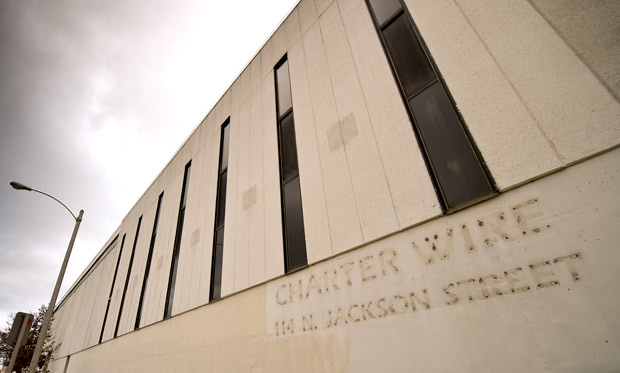Lawsuit over worker’s fall raises questions, could change current rule
By: Erika Strebel, [email protected]//October 27, 2016//
Lawsuit over worker’s fall raises questions, could change current rule
By: Erika Strebel, [email protected]//October 27, 2016//

Should a company be held liable when it vacates a building and leaves behind dangerous conditions that later lead to a worker’s injury?
That question was before the Wisconsin Supreme Court on Wednesday. In Brenner v. National Casualty Co., the justices are asked to consider whether the state’s current rule for assigning liability in such cases should be jettisoned in favor of a new one.
Charles Dykman, a law professor and former appellate judge, says the courts have been looking at the case in entirely the wrong way. The real issue, he argues, is that Wisconsin has two methods of determining negligence. The courts, he says, should choose one and stick with it.
Setting ground rules
The first way to go about assigning liability in such cases is to adopt rules like those found in the Restatement (Second) of Torts — a summary of legal rules and principles of tort law. These set out certain fact patterns determining when liability should be limited.
The second is to use a long-standing analysis method holding that negligence claims must contain four basic elements: duty, breach, causation and damages. The existence of two differing approaches has been known to lead to confusion.
But it hasn’t always been this way, says Steven Barkan, a law professor and colleague of Dykman’s at the University of Wisconsin Law School. Barkan noted that few rules of this sort existed when the state had a liberal-leaning Supreme Court in the 1960s, ‘70s and ‘80s.
Since then, the court has adopted rules that include sections 352 and 353 of the Restatement (Second) of Torts. These are the same rules that a Milwaukee trial court judge and the District 1 Court of Appeals used to find that a former tenant of a building in Milwaukee should not be held liable for injuries that occurred after it had vacated the premises.
The tenant, Charter Wire Co., had occupied 607 E. Polk St. for years and had furnaces installed in building’s northwest corner. Those furnaces were removed when Charter left in 2009. Left behind were several holes in the floor that were covered with plywood.
Years later, Russell Brenner, then an employee of Hunzinger Construction, fell through one of the holes while renovating the building. By that time, the building had a new occupant: Milwaukee World Festival Inc., a group best known for organizing Summerfest every year along Milwaukee’s lakefront.
Milwaukee County Circuit Court Judge Richard Sankovitz found that Section 352 and 353 of the Restatement (Second) of Torts prevented any party — save for Milwaukee World Festival and its insurers — from being held liable for Brenner’s injury. Charter should not be deemed responsible, the court found, because it was not in possession of the building at the time of the injury.
The Court of Appeals later agreed.
In its current appeal, Milwaukee World Festival is calling on the state Supreme Court to adopt rules found in a more recent summary of the common law concerning torts: the Restatement (Third) of Torts. This, Milwaukee World Festival argues, would let Brenner also recover damages from Charter.
Brenner and his legal representatives are, on the other hand, saying that current law should be kept. For one, they say, any possible changes would likely have consequences for both insurance policies and property owners and thus would be best left to the Legislature.
Barkan, for his part, says he thinks the Court of Appeals got the decision right because state case law allows a court to adopt rules laid out in any Restatement and use them in addition to the more standard sort of analysis applied in negligence cases.
Keeping with tradition
Dykman, on the other hand, says the issue in Brenner should have been decided using nothing but the analysis method looking for the four elements of duty, breach, causation and damages. He had hoped to be able to explain his reasons to the justices, but his motion to submit an amicus brief in the case was denied.
“What I think I said was we don’t need two ways of arriving at the answer,” he said. “They’re incompatible with each other.”
For the time being, it is up to the courts to decide which approach best suits the state. Dykman said he prefers the long-standing analysis method for two reasons: It results in opinions that are more transparent and it forces judges to explain what they are doing and why they are doing it.
“Judges can’t hide a decision using words that nobody really understands,” Dykman said.
“If a judge is going to throw out a case over public policy, you have to explain it,” he added. “The analysis requires the explanation.”
Reading the tea leaves
Barkan says he suspects the high court will take one of two courses in Brenner: either clarify current law or make new law.
He said he would be surprised if the justices chose the latter course. He noted that the Supreme Court is now dominated by conservatives, who tend to prefer limiting liability over expanding it.
But because the justices denied his motion to file an amicus brief in the case, they won’t have a chance to hear his views.
“The train left the station with the Restatement on board,” Dykman said. “It’s very hard to change the entire analysis when the train is running.” Follow @erikastrebel
Legal News
- Some State Bar diversity participants walk away from program
- Wisconsin court issues arrest warrant ‘in error’ for Minocqua Brewing owner
- Iranian nationals charged cyber campaign targeting U.S. Companies
- Facing mostly white juries, are Milwaukee County defendants of color truly judged by their peers?
- Milwaukee Mayor speaks in D.C. Tuesday at White House water summit
- Chicago man sentenced to prison after being caught with ‘Trump Gun’
- FTC bans non-competes
- Gov. Evers seeks applicants for Dane County Circuit Court
- Milwaukee man charged in dismemberment death pleads not guilty
- Democratic-led states lead ban on the book ban
- UW Madison Professor: America’s child care crisis is holding back moms without college degrees
- History made in Trump New York trial opening statements
WLJ People
- Power 30 Personal Injury Attorneys – Russell Nicolet
- Power 30 Personal Injury Attorneys – Benjamin Nicolet
- Power 30 Personal Injury Attorneys – Dustin T. Woehl
- Power 30 Personal Injury Attorneys – Katherine Metzger
- Power 30 Personal Injury Attorneys – Joseph Ryan
- Power 30 Personal Injury Attorneys – James M. Ryan
- Power 30 Personal Injury Attorneys – Dana Wachs
- Power 30 Personal Injury Attorneys – Mark L. Thomsen
- Power 30 Personal Injury Attorneys – Matthew Lein
- Power 30 Personal Injury Attorneys – Jeffrey A. Pitman
- Power 30 Personal Injury Attorneys – William Pemberton
- Power 30 Personal Injury Attorneys – Howard S. Sicula











